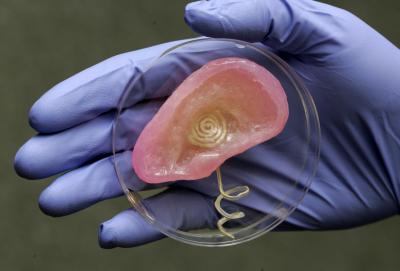3D Printed Ear 2.0

Scientists used 3D printing to merge tissue and an antenna capable of receiving radio signals. Courtesy of Princeton University.
Latest News
May 9, 2013
I’m not sure what it is about ears and additive manufacturing (AM) that’s grabbed the attention of researchers, but apparently the two work well together. It wasn’t all that long ago that Rapid Ready reported on Cornell University’s bioprinted ear, and now Princeton University has performed the same feat, albeit with a different focus.
Where Cornell researchers were focused on creating a prosthetic for children who suffer from a congenital deformity, Princeton’s team has put its efforts toward battling hearing loss. Princeton’s ear was built using AM to combine biology and electronics. The result is a prosthetic that could not only boost a user’s hearing, but also allow him to pick up radio signals.
“In general, there are mechanical and thermal challenges with interfacing electronic materials with biological materials,” said Michael McAlpine, an assistant professor of mechanical and aerospace engineering at Princeton and the lead researcher. “Previously, researchers have suggested some strategies to tailor the electronics so that this merger is less awkward. That typically happens between a 2D sheet of electronics and a surface of the tissue. However, our work suggests a new approach — to build and grow the biology up with the electronics synergistically and in a 3D interwoven format.”
The researchers used an ordinary 3D printer to mix hydrogel and calf cells with silver nanoparticles. The calf cells eventually develop into cartilage, and the silver nanoparticles form an antenna. This combination essentially forms a biological/technological body part that sci-fi fans might name a cybernetic ear.
While this is a cool development, don’t expect to be replacing hearing aids with cyber ears just yet. Although the theory is sound, the researchers have yet to figure out how to connect the ear with nerve endings that would allow for hearing. Once that hurdle is crossed, the prosthetic will have to go through the standard rounds of medical testing before it becomes available to the general public.
Below you’ll find a video about Princeton’s achievement.
Source: EurekaAlert
Subscribe to our FREE magazine, FREE email newsletters or both!
Latest News
About the Author
John NewmanJohn Newman is a Digital Engineering contributor who focuses on 3D printing. Contact him via [email protected] and read his posts on Rapid Ready Technology.
Follow DE






